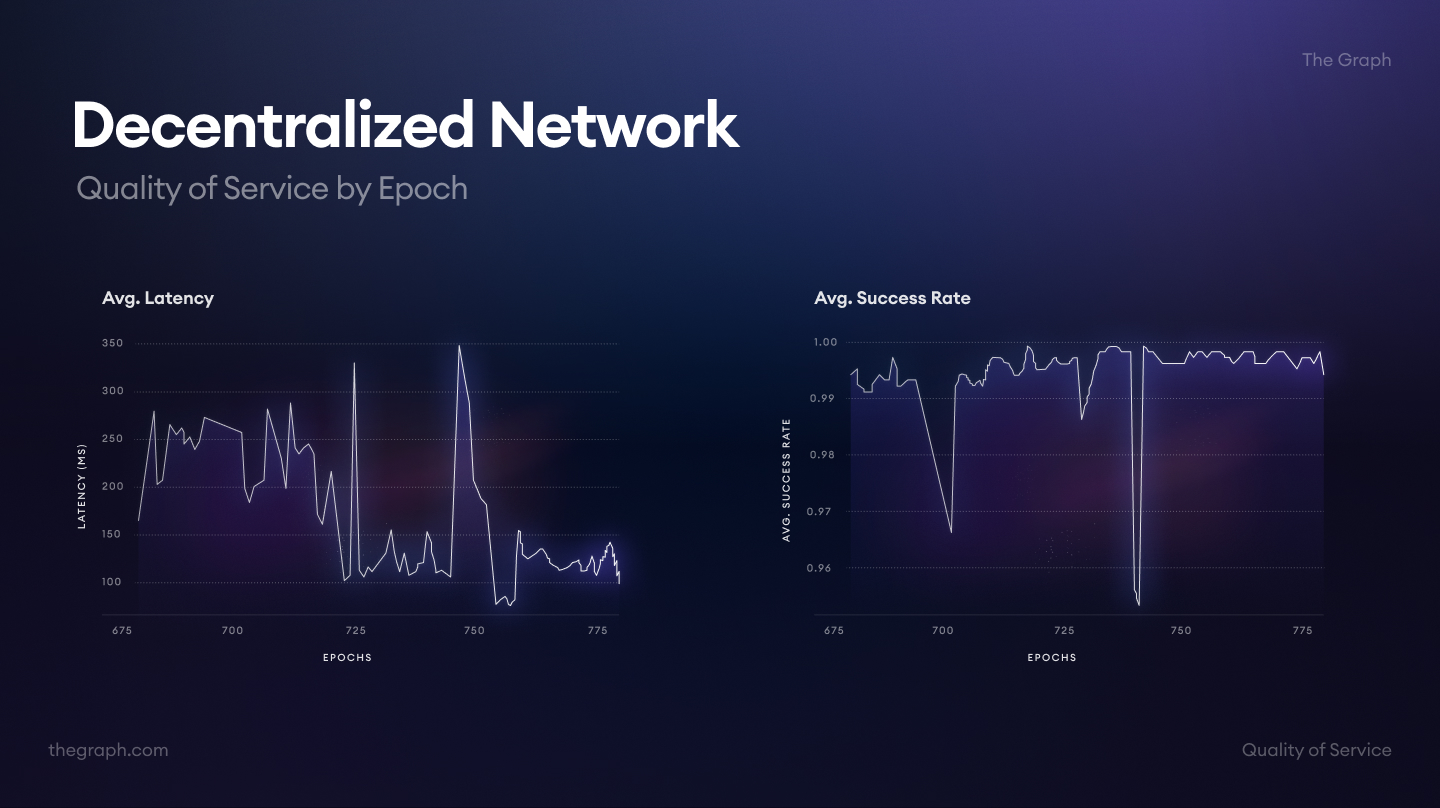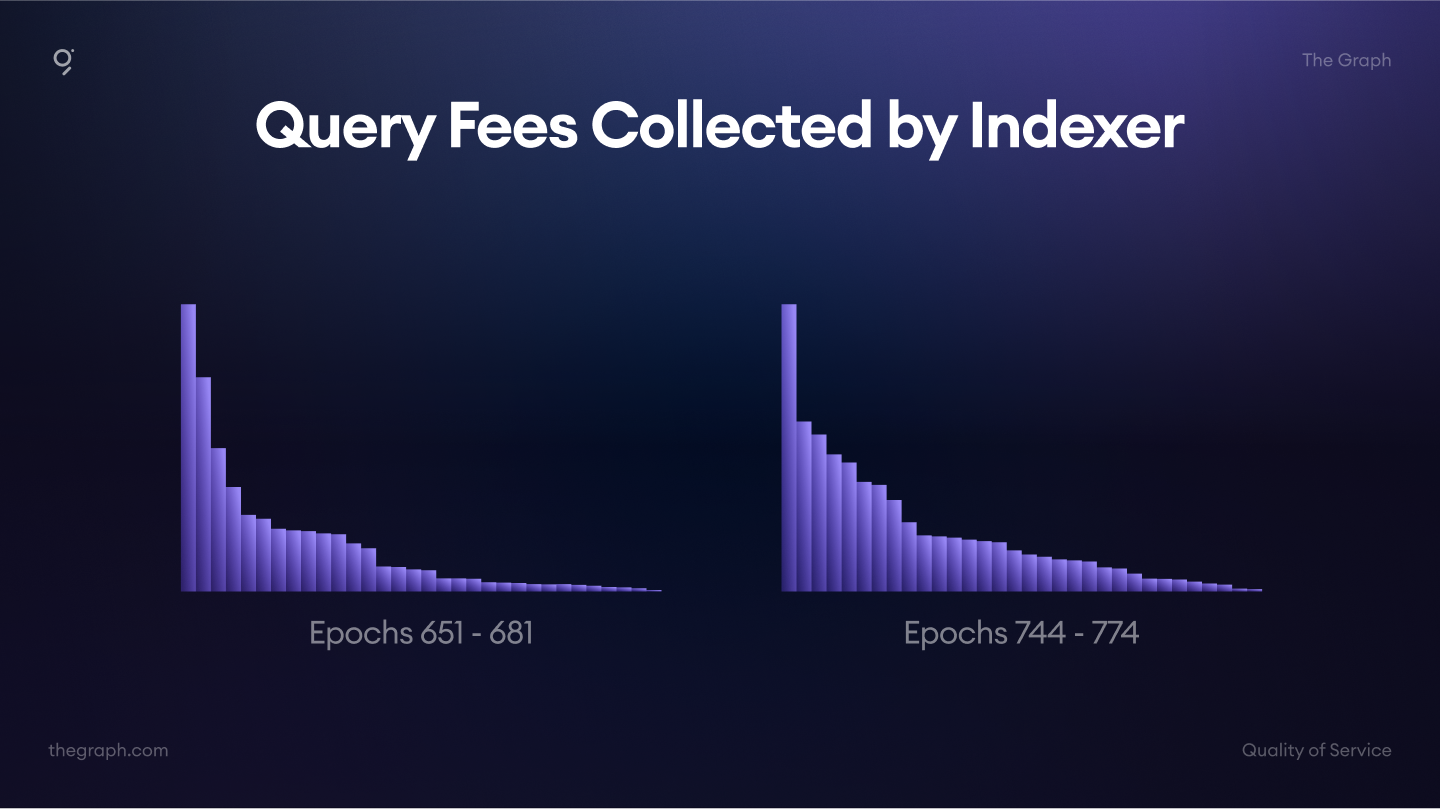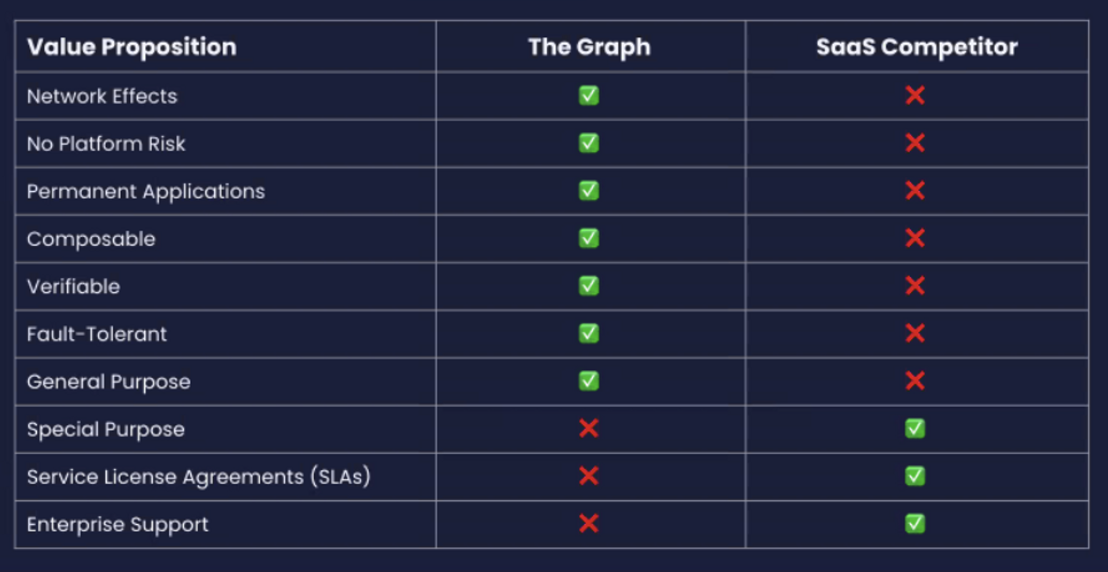

The Graph’s Quality of Service Beats Centralized Alternatives
This blog is brought to you by Theo Butler, software engineer at , and Michael Macaulay, a technical writer at , a core developer of The Graph.
In recent years, decentralized networks have emerged as a promising alternative to centralized systems. This new paradigm has faced a consistent criticism: decentralized networks must sacrifice quality of service to maintain decentralization. Today, The Graph’s decentralized network is shattering this false belief with a quality of service (QoS) not only on par with centralized alternatives, but increasingly superior as well.
The Graph has surpassed in June 2022, and quality of service on The Graph has increased substantially with lower latencies and higher success rates by leveraging the hundreds of independent Indexers running nodes on the network. Anyone can take advantage of these benefits by querying blockchain data with subgraphs.
Let’s explore the data and why the nature of The Graph’s decentralized infrastructure is directly responsible for the impressive quality of service, along with other improvements that have occurred since the last major quality of service highlight . The characteristics and performance of The Graph Network are a clear demonstration of what can be difficult to replicate with centralized alternatives.
The Data Speaks for Itself
The following plots show daily averages for two of the most important quality of service metrics for subgraph users: latency & success rate. The data for these plots comes directly from the & created by members of two core developer teams, Craig Tutterow from Edge & Node and Juan Manuel Rodriguez Defago from GraphOps.
Both plots are time series from 678 to epoch 783, which correspond to 2022/10/26 and 2023/02/08, respectively. For average latency (on the left) lower values are better, implying less time is needed, on average, to receive query responses. For success rate (on the right) higher values imply more queries are successful on average. Based on the time frame, we see significant improvement overall, especially around late November 2022. During this time, average latencies dropped by about 40%.

Footnote: The QoS Oracle and subgraph were still under active development during the period where substantial network QoS improvements occurred. So some data points are missing within the time range used, especially from last year (Epocs 693-699, 722, 730, & 731). Also, note that data from this subgraph does not filter out query failures that are attributable to user error.
Another positive impact of the recent improvements to the network is that query fees are being distributed more evenly across Indexers. Unlike indexing rewards, query fees received are directly influenced by the quality of service that Indexers provide to users of The Graph at query time. The plots below show the overall distribution of query fees collected per Indexer over 30-day periods.
The plot on the left is for around October 2022, and the plot on the right is for approximately January 2023. The recent distribution is more evenly distributed, indicating that query fees are being distributed more evenly than last year as a result of queries on the network being served by more Indexers. Further competition within the query market may also enhance the distribution of query fees, coupled with overall Indexer quality increases, and the reducing the cost for Indexers to collect fees.

The significant improvements in both quality of service and the Indexer experience are a testament to the dedication and commitment of The Graph’s core developers, network participants, and countless other contributors in The Graph ecosystem to enable a decentralized way to access public data while making no sacrifices on performance. Decentralization allows anyone to create more robust infrastructure systems while leveraging network effects to do what is difficult with centralized alternatives. Anyone can analyze QoS in real-time with .
Why Decentralization Improves Quality of Service
The Graph is decentralized because the nodes that index subgraph data and serve queries are operated by independent Indexers. Each individual Indexer has to make decisions related to tradeoffs, in terms of latency, success rate, data freshness, etc. On each subgraph, multiple Indexers are competing to serve accurate data queries. This competition results in better outcomes for data consumers.
One technical challenge users face on the decentralized network, that doesn’t apply to centralized offerings, is the complexity of selecting the best Indexer to serve any given query. However improvements made to the Graph Explorer and other UIs interacting with the network can simplify this experience and reduce overhead of Indexer selection. Indexers compete for users based on their services and tradeoffs, and the network is a highly dynamic system where new Indexers may spin up, and others may have sudden outages or degraded performance. At a high level, the improvements made near the end of last year better leverage the redundancy of available Indexers per query. Presently, queries are often served by multiple Indexers at the same time to avoid negative outcomes that often manifest themselves as high latency, or timeouts in the worst cases.
These improvements are especially beneficial for data consumers in scenarios where Indexer selection is even more challenging. Such scenarios include deploying new subgraphs, upgrading existing subgraphs, and subgraphs with very low query volume. In these situations, it's hard to predict the quality of service of individual Indexers. However, redundancy in these cases compensates for low confidence and helps the protocol adapt more rapidly.
The Graph Network is achieving a quality of service that is difficult to match with centralized alternatives, . The hosted service has been a temporary scaffold used to onboard subgraph developers while also enabling The Graph Network to prepare and establish network readiness, identify product-market fit, and build an ecosystem of active contributors.The Graph Network outperforming the hosted service marks a significant achievement for decentralization, with plans for even more improvements in the future.

Beyond the hosted service, building on decentralized infrastructure via The Graph Network offers benefits that are difficult to replicate with centralized systems. These benefits include the openness and composability of public subgraphs (rather than proprietary APIs), the advantage of network effects, such as the redundancy of Indexers, and the ability to build unstoppable applications with data flows that are more resistant to being shut down by a centralized entity.
The Graph Network’s quality of service is further bolstered by unique characteristics that are difficult to replicate with alternatives that are wholly owned, operated, and governed by centralized entities.

Conclusion
Performance on The Graph Network has come a long way. Average query latency has halved since last year, and average success rates keep increasing. Quality of service is only going to continue increasing. The move to Arbitrum will also drive additional network participation and increase the efficiency of Indexers.
The future of the internet is bright, and The Graph is here to enable developers to create unstoppable applications strengthened and secured by credibly neutral, performant, and reliable decentralized infrastructure.
About The Graph
is the source of data and information for the decentralized internet. As the original decentralized data marketplace that introduced and standardized subgraphs, The Graph has become web3’s method of indexing and accessing blockchain data. Since its launch in 2018, tens of thousands of developers have for dapps across 70+ blockchains - including Ethereum, Solana, Arbitrum, Optimism, Base, Polygon, Celo, Fantom, Gnosis, and Avalanche.
As demand for data in web3 continues to grow, The Graph enters a with a more expansive vision including new data services and query languages, ensuring the decentralized protocol can serve any use case - now and into the future.
Discover more about how The Graph is shaping the future of decentralized physical infrastructure networks (DePIN) and stay connected with the community. Follow The Graph on , , , , , and . Join the community on The Graph’s , join technical discussions on The Graph’s .
oversees The Graph Network. The Graph Foundation is overseen by the . , , , , , and are eight of the many organizations within The Graph ecosystem.

